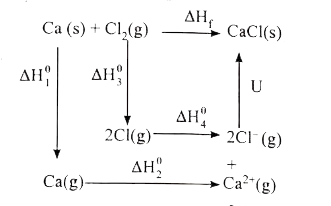Calculate the lattice energy of CaCl2 from the given data.
Ca(s)+Cl2(g)→CaCl2(s)ΔH0f=−795kJ mol−1
Sublimation : Ca(s)→Ca(g) ΔH01=+121kJ mol−1
Ionisation : Ca(g)→Ca2+(g)+2e− ΔH02=+2422kJ mol−1
Dissociation : Cl2(g)→2Cl(g) ΔH03=+242.8kJ mol−1
Electron affinity : Cl(g)+e−→Cl−(g) ΔH04=−355kJ mol−1 Solution in Tamil

ΔHf=ΔH1+ΔH2+ΔH3+2ΔH4+u
-795=121+2422+242.8+(2 x -355) + u
-795 =2785.8-710 +u
-795=2075.8 + u
u=-795-2075.8
u=−2870.8kJ mol−1
Topper's Solved these Questions
- THERMODYNAMICS BOOK - FULL MARKSCHAPTER - THERMODYNAMICS EXERCISE - In-Text Questions -Evaluate Yourself
8 Videos
- THERMODYNAMICS BOOK - FULL MARKSCHAPTER - THERMODYNAMICS EXERCISE - Additional Questions Solved (I)
39 Videos
- THERMODYNAMICS BOOK - FULL MARKSCHAPTER - THERMODYNAMICS EXERCISE - Textual Question Solved (MCQs)
25 Videos
- SOLVED PAPER 13 (UNSOLVED)BOOK - FULL MARKSCHAPTER - SOLVED PAPER 13 (UNSOLVED)EXERCISE - PART-II
9 Videos
Similar Questions
Calculate ΔH∘f for the reaction CO2(g)+H2(g)→CO(g)+H2O(g) given that ΔH0f for CO2(g),CO(g) and H2O(g) are -393.5 , -111.31 and −242kJ mol−1 respectively.
View SolutionIn which of the following process, the process is always non-feasible?
View SolutionThe amount of heat exchanged with the surrounding at constant quantity ______
View SolutionDefine - equivalent mass.
View SolutionThe enthalpy changes for the following process are listed below : Cl_(2)(g)=2Cl(g)," "242.3" kJ"mol^(-1) I_(2)(g)=2I(g)," "151.0" kJ"mol^(-1) ICl(g)=2I(g)+Cl(g)," "211.3" kJ"mol^(-1) I_(2)(s)=I_(2)(g)," "62.76" kJ"mol^(-1) Given that standard states for iodine and chlorine are I_(2)(s) and Cl_(2)(g) , the standerd enthalpy of formation for ICl(g) is :
View SolutionThe standard enthalpy of formation of H_(2)(g) and Cl_(2)(g) and HCl(g) are 218 kJ//mol , 121.88 kJ//mol and -93.31 kJ//mol respectively. Calculate standard enthalpy change in kJ for (1)/(2)H_(2)(g)+(1)/(2)Cl_(2)(g)toHCl(g)
View SolutionCalculate lattice energy for the change,
Li+(g)+Cl−(g)→LiCl(g)
Given that
ΔHsublimation of Li=160.67kJmol−1,ΔHDissociation of Cl2=244.34kJmol−1,ΔHionisation of Li(g)=520.07kJmol−1,ΔHE.A of Cl(g)=−365.26kJmol−1,ΔHf of LiCl(s)=−401.66kJmol−1,
View SolutionThe ΔH0f(KF,s) is −563kJmol−1. The ionization enthalpy of K(g) is 419kJmol−1. and the enthalpy of sublimation of potassium is 88kJmol−1. The electron affinity of F(g) is 322kJmol−1 and F−F bond enthalpy is 158kJmol_1. Calculate the lattice enthalpy of KF(s).
The given data are as follows:
(i) K(s)+1/2F2(g)→KF(s) ΔH0f=−563kJmol−1
(ii) K(g)→K+(g)+e− Δ0Ioniz=419kJmol−1
(iii) K(s)→K(g) ΔH0sub=88kJmol−1
(iv) F(g)+e−→F−(g) ΔH0eg=−322kJmol−1
(v) F2(g)→2F(s) ΔH0diss=158kJmol−1
(vi) K+(g)+F−(g)→KF(s) ΔH0L=?
View SolutionThe standard enthalpy of formation of H2(g) and Cl2(g) and HCl(g) are 218kJ/mol, 121.88kJ/mol and −93.31kJ/mol respectively. Calculate standard enthalpy change in kJ for
12H2(g)+12Cl2(g)→HCl(g)
View SolutionThe enthalpy change for the following processes are listed below {:(Cl_(2)(g)=2 Cl(g),242.3 kJ mol^(-1)),(I_(2)(g)=2I(g),151.0 kJ mol^(-1)),(ICl(g)=I(g)+Cl(g),211.3 kJ mol^(-1)),(I_(2)(s)=I_(2)(g),62.76 kJ mol^(-1)):} Given that the standard states for iodine and chlorine are I_(2)(g) and Cl_(2)(g) , the standard enthalpy of formation for ICl(g) is
View SolutionCalculate the enthalpy of formation of anhydrous Al_(2)Cl_(6) from the following data : (i) 2Al(s) + 6HCl(aq) rarr Al_(2)Cl_(2) + 3H_(2)(g) + 1004.2kJ .kJ mol^(-1) (ii) H_(2)(g) +Cl_(2)(g) rarr 2HCl(g) + 184.1 kJ mol^(-1) (iii) HCl(g) + aq rarr HCl(aq) + 73.2kJ mol^(-1) (iv) Al_(2)Cl_(6)(s) +aq rarr Al__(2)Cl_(6)(aq) +643.1 kJ mol^(-1)
View SolutionCalculate lattice energy for the change,
Li+(g)+Cl−(g)→LiCl(g)
Given that
ΔHsublimation of Li=160.67kJmol−1,ΔHDissociation of Cl2=244.34kJmol−1,ΔHionisation of Li(g)=520.07kJmol−1,ΔHE.A of Cl(g)=−365.26kJmol−1,ΔHf of LiCl(s)=−401.66kJmol−1,
View SolutionCalculate the lattice energy of formation of NaCl from the following data :
Na(s)+1/2Cl2(g)→NaCl(s)ΔHf−411.3KJ.mol−1
Heat of sublimation of Na(s)=108.7kJmol−1
Ionisation energy of Na(g)=49.5.0kJmol−1
Dissociation energy of Cl2(g)=244kJmol−1
Electron affinity of Cl(g)=−349.0kJmol−1
View SolutionUsing the data provided, calculate the multiple bond energy ( kJ "mol"^(-1) ) of a C equiv C bond in C_(2)H_(2) .That energy is (take the bond enrgy of a C-H bond as 350 kJ "mol"^(-1) ): 2C(s) + H_(2)(g) to C_(2)H_(2)(g), DeltaH = 225 kJ "mol"^(-1) 2C(s) to 2C(g), DeltaH = 1410 kJ "mol"^(-1) H_(2)(g) to 2H(g), DeltaH = 330 kJ "mol"^(-1)
View SolutionFor one mole of NaCl(s) the lattice enthalpy is : Na(s) + (1)/(2)Cl_(2)(g) overset(+108.4 kJ//mol)rarr Na(g) + (1)/(2)Cl_(2)(g) overset(+495.6 kJ//mol)rarr Na^(+)(g) + (1)/(2)Cl_(2)(g) overset(121 kJ//mol)rarr Na^(+)(g) + Cl(g) overset(-348.6 kJ//mol)rarr Na^(+)(g) + Cl^(-)(g) overset(Delta H^(theta)" lattice")rarr NaCl("solid") underset(-411.2 kJ/mol)larr Na(s) + (1)/(2)Cl_(2)(g)
View Solution
